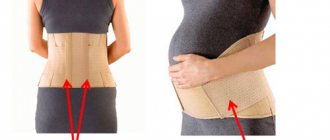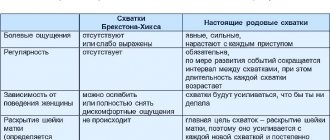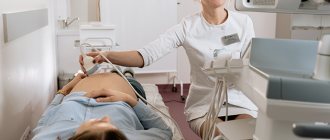What organs are located on the right side of the abdomen? What can hurt?
The content of the article
The “belly” is a single complex system, including organs and the structures connecting them. It is difficult for a person without medical education to understand which organ caused the pain, so when the stomach hurts, first of all the patient characterizes the pain according to its location. The doctor is told that the right or left side, lower abdomen hurts, pain is felt in the navel area, etc. And only then does it become clear what exactly is bothering you and for what reason.
To understand what exactly can hurt on the right side during pregnancy, let's try to look inside the belly of a pregnant woman. To do this, let’s divide the right side of the abdomen into upper and lower parts.
- At the top are the liver, bile ducts, gallbladder, parts of the intestines, stomach and diaphragm, kidney, duodenum.
- In the lower part there is the ureter, fallopian tubes, appendix, ovary with epididymis, small and large intestines.
Pregnancy creates a high load on the entire body and the pelvic organs in particular. This leads to the fact that the functions of many organs are subject to change. Under the growing weight of the fetus and amniotic fluid, they are displaced, compressed, their activity is weakened, and blood circulation is disrupted.
Weakened immunity and changes in hormonal levels give the green light to the development of sleepers and the exacerbation of chronic infections. The result is the resumption of old problems and the emergence of new problems that have never bothered a woman before.
Therefore, any of the above organs can hurt in the right side during pregnancy; how dangerous this is depends on the causes of the pain.
Diagnostics
To diagnose the disease, the patient must describe the clinical picture to the doctor in detail. Based on the symptoms they do:
- Ultrasound of the pelvic organs. Helps identify gynecological pathologies, ectopic pregnancy and neoplasms.
- Ultrasound to monitor the condition of the fetus.
- Computed tomography. This diagnostic method gives an idea of the clinical picture, records the onset of the development of pathology, and determines the nature of the tumors.
- Laboratory examination of urine and blood. Makes it possible to determine inflammation outside the reproductive system.
Causes, symptoms and nature of pain in the right side
Pain in the right side can be caused by a number of serious reasons. Therefore, when the first signs appear, it is important to analyze what exactly led to such manifestations, as well as take into account the symptoms that accompany the appearance of painful sensations.
The pain can be weak or strong, nagging or sharp, constant or episodic, it can be caused simply by an enlarged uterus or serious illness. You also need to understand whether they are localized at one point or distributed to other organs. Answers to these questions are important for timely provision of assistance. Let's consider the most common causes of pain in the right side in pregnant women:
- Normal physiological state during pregnancy.
The pain is short-term (up to 15 minutes), mild. It may be a consequence of pressure from the heavier uterus on one or another organ. - Stretching of the uterus.
The pain is localized in the lower part, has a long-lasting and aching character, and intensifies when the baby moves. This pain occurs due to stretching of the uterus: the child begins to gain weight and puts pressure on the muscles. This symptom is also characteristic of an impending miscarriage, so it is important to evaluate the discharge. If there is blood in them, you should contact a gynecologist immediately. - Stones in the ureter
. Unpleasant pain in the lower right abdomen. It occurs due to pressure from the enlarged uterus on the ureter. For the same reason, pregnant women experience frequent urination. The second cause of pain in the ureter is a small stone getting stuck at the exit of the kidney. In this case, the pain is very strong, comes in waves, and radiates to the groin. This condition is called colic - Ectopic pregnancy
. Symptoms: fever, nausea and vomiting, acute prolonged pain, bleeding. The fertilized egg does not enter the uterus; it begins to grow and develop in the fallopian tube, which ruptures as the fetus enlarges. In this case, at first the symptoms may be as in a normal full pregnancy. If a woman has not had an ultrasound, it is very easy to miss an ectopic pregnancy. - Appendicitis.
The pain is localized in one specific place (it is easy to point to it), it is very acute, long-lasting, accompanied by an increase in temperature, the appearance of nausea (vomiting), and a general severe state of malaise. Occurs due to inflammation of the appendix. - Ovarian cyst.
If the cyst was in the ovary before pregnancy, the pain occurs aching and dull due to irritation of nerve receptors due to the growth of the fetus. If the cyst ruptures, the pain becomes acute and occurs in attacks. Additional symptoms: sharp pain when pressing on the abdomen, discomfort in the anus (pushing), bleeding, loss of consciousness. - Inflammation of the gallbladder (cholelithiasis).
Very severe pain radiating to the back, accompanied by nausea and profuse sweating. The condition is very dangerous; if you do not see a doctor, the pain can become unbearable. - Liver inflammation, poisoning
. In addition to pain in the right side, symptoms such as yellowing of the skin and whites of the eyes, and changes in the color of urine (darkening) are identified. Cause: liver inflammation, hepatitis. - Infectious diseases of the genitourinary system.
Long-term aching and dull pain. Occurs during various inflammations, for example, cystitis, etc.
Also among the causes of pain on the right side of the abdomen in pregnant women, one cannot but mention constipation and hemorrhoids.
Characteristics of possible pain by trimester of pregnancy
1st trimester (from conception to 12 weeks)
. During this period, the fetus is actively growing. A pregnant woman often experiences various kinds of physiological pain, as the uterus grows, puts pressure on all organs, and changes the work processes that have been established over the years. The main risks of this period are miscarriage and ectopic pregnancy.
The body completely adapts to its new state, hormonal changes occur. Often a woman suffers from toxicosis (general weakened state, drowsiness, dizziness, loss of appetite, nausea, and so on). In some cases, toxicosis also leads to pain in the right side of the abdomen. 2nd trimester (from 13 to 27 weeks)
.
Pain during this period may occur due to stretching of the ligaments that support the uterus, which significantly increases in size. In the second trimester, it is very important to monitor nutrition, since this period often opens up various gastronomic desires in pregnant women after toxicosis. Overeating, heavy foods, fatty foods - all this negatively affects the functioning of the intestines, which in turn can lead to constipation and various types of abdominal pain. Also at this time there is a high probability of dyskinesia (impaired motility) of the biliary tract. Symptoms: the appearance of pain, a feeling of heaviness and fullness in the right hypochondrium. The reasons may vary. The most dangerous is an attack of gallstone disease. Nevertheless, among the causes are often identified: psychogenic factors, unhealthy diet, hormonal imbalance, growth of the uterus and its pressure on the organs. 3rd trimester (from 28 weeks to birth).
During this period, the fundus of the uterus rises high, which causes maximum pressure on the surrounding organs (stomach, pancreas, diaphragm, gall bladder), as a result of which discomfort is felt and blood circulation is impaired. It is also important to take into account that during this period any activity of the baby is strongly felt. If the child rests against any organ (or hits it sharply), then the expectant mother feels severe pain. It is typical that such pain goes away instantly if you try to change the position, thereby moving the child a little, relieving the organ from excessive pressure.
How to alleviate the condition?
Moderate physical activity during pregnancy is a necessary measure for targeted stretching of the muscles and ligaments of the perineum. Regular gymnastic exercises prepare the body for childbirth. Here is an approximate complex that every pregnant woman can take note of:
- Get down on your knees, spread them shoulder-width apart and sit between them on your buttocks. This is a classic pose for stretching the perineal ligaments. If physical fitness permits, the woman can slowly and carefully lower herself from this position onto her back—this position is known as the fish position.
- Sit on a flat surface, bend your knees and pull your legs towards you, grabbing your heels. Now rest your feet against each other, and try to reach the floor with your knees apart. This exercise is called the butterfly.
- To relieve pain in the lower abdomen during pregnancy, a woman needs to learn to relax and contract the muscles of the perineum. It is enough to master the following exercise: imagine that you really want to go to the toilet in a small way, but there is no way to empty your bladder, so you have to endure it. To do this, you need to force your willpower to tense the muscles of your perineum for 10 seconds and then relax. Repeat the exercise several times in a row, it is especially important to do this when there is very little time left before giving birth.
Self-help for pain in the right side
If you experience pain in the right side during pregnancy, it is important to evaluate the symptoms. If there are no direct indications for immediate medical attention (bleeding, severe or persistent pain, fever, vomiting), then think about the reasons that could lead to this condition. To begin with, it is important to calm down and lie down comfortably, change several positions and find one that reduces the pain.
Remember that if the day before, how long ago you last went to the toilet. If the pain does not go away, be sure to seek help. If she quiets down and never returns, pay attention to your regimen. Get more rest, walk in the fresh air, balance your diet, and choose foods that do not cause constipation. Reduce fluid intake and wear a bandage. The most important thing is to be positive and calm. Any medications during pregnancy can be taken strictly as prescribed by the doctor. They can harm the baby or cause miscarriage. Do not self-medicate, be careful with traditional medicine recipes, be especially careful when handling a heating pad; for many diseases, it can significantly worsen the condition. If the symptoms are dangerous, make an appointment with a doctor or call an ambulance. Before the doctors arrive, try to calm down and not panic. This is very important not only for you, but also for the baby, who feels his mother’s worries.
Why is pain dangerous?
But there are also dangerous obstetric pains that arise from the following problems in the body:
- Threat of miscarriage
. At the same time, there is aching and pulling in the lower abdomen and lumbar region. Bloody discharge is also added to the pain. You can avoid an unfavorable outcome only by seeking medical help in a timely manner. If no measures are taken, the pain becomes cramping, bleeding increases and spontaneous miscarriage occurs. - Ectopic pregnancy
. If the embryo begins to form not in the uterus, but, for example, in the fallopian tube, then we are talking about an ectopic pregnancy. This is a dangerous pathology for a woman’s health due to the high risk of internal bleeding, requiring urgent surgical intervention. Every woman of childbearing age should know the signs of an ectopic pregnancy in order to consult a doctor in time and prevent complications. - Premature placental abruption
. It can be triggered by gestosis, injuries in the abdominal area, a short umbilical cord and other pathologies. In this case, the pain in the abdomen is very severe, internal bleeding may occur without external discharge. In this case, only forced delivery and stopping the bleeding can save the woman and child. - Uterine tone
. “Uterine hypertonicity” can more often occur in the early stages of pregnancy. Uterine tone during pregnancy is contractions that appear before the expected due date. They are felt as pulling, aching pain in the lower abdomen (a similar condition during menstruation), sometimes pain in the lower back.
Among non-obstetric abdominal pains during pregnancy, surgical pathologies or certain diseases most often occur. The danger of intestinal infections during pregnancy is that, together with intestinal tone, they cause uterine tone.
Self-treatment with improvised means or contacting a gynecologist?
Any pain is not normal, it shouldn’t be like that. But pain is not always a signal of alarm; often the stomach hurts in conditions of discomfort or as a warning that something needs to be changed (for example, posture or, more generally, diet). The most common causes of abdominal pain are digestive problems, as well as the result of the growth of the uterus and weight gain of the child.
If your stomach is a little achy, it is important to evaluate the presence or absence of any other accompanying symptoms. Pain that lasts no more than a few minutes and does not recur is considered acceptable. Pain that goes away after the pregnant woman lies down or goes to the toilet. Please note that the most “safe” painful trimester is the third, because the fetus reaches its maximum size and its pressure on the organs is too great.
Unfortunately, it happens that abdominal pain is a symptom of pathology, so if you value this pregnancy, contact a gynecologist at the Diana Clinic. The doctor will perform an ultrasound of the pelvis and an ultrasound of the abdominal cavity. Usually these two inexpensive tests are enough to make a diagnosis and take action.
In what cases is it necessary to immediately contact a gynecologist?
- A sharp sharp pain appeared in the abdominal area.
- It does not stop hurting after 30 minutes, there is a feeling that the pain is getting stronger and stronger.
- Unpleasant stretching and pain for 2 days.
- Pain in the right side combined with dangerous symptoms: fever, chills, nausea, vomiting, increased sweating, rash, etc.
Remember that without medical education, you and your relatives can only make a conditional diagnosis on your own. It is important to know the causes and symptoms in order not to stay at home in case of real danger, and not for self-medication.










